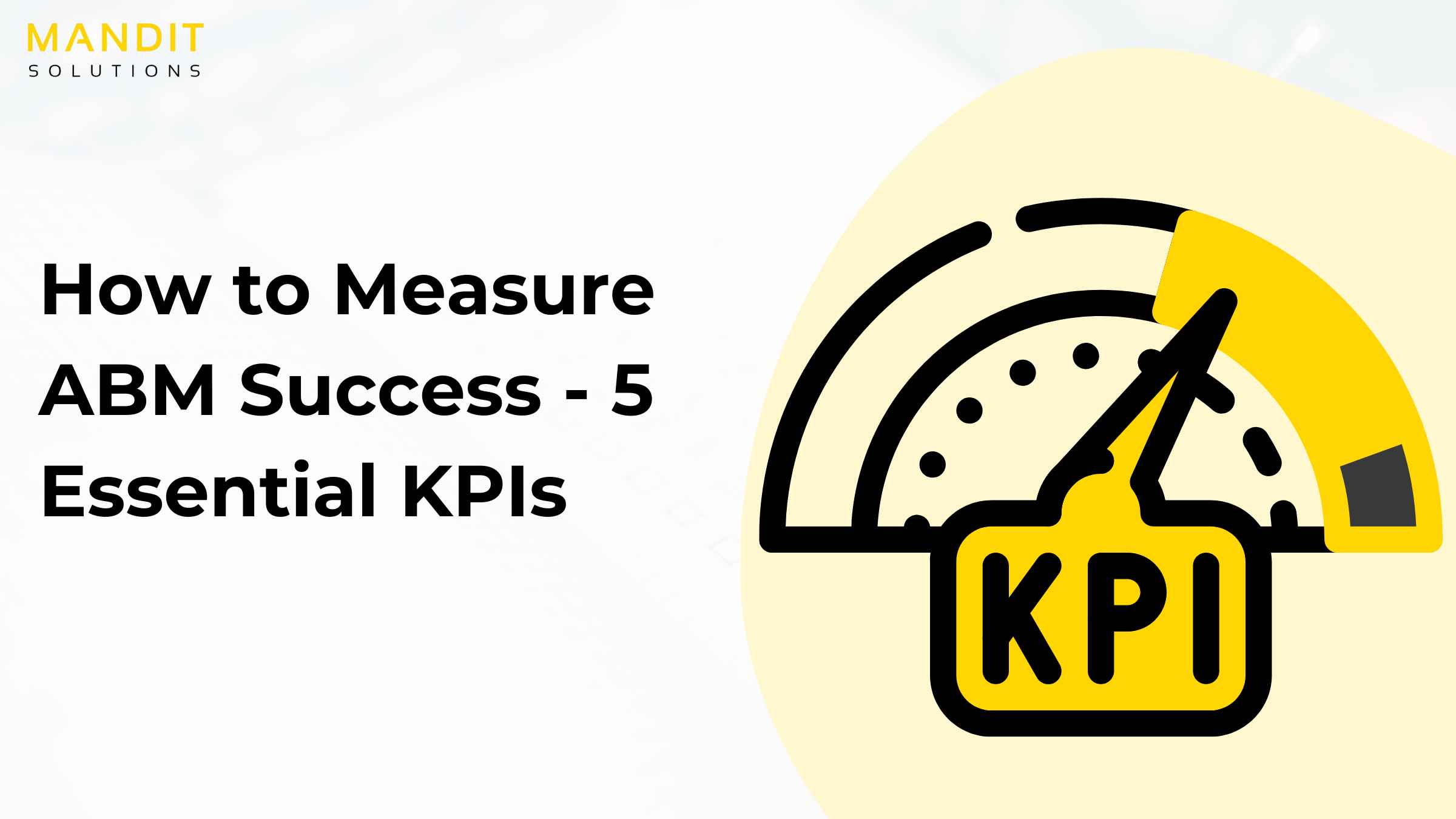
Account-based marketing has emerged as the most sought-after marketing technique for B2B enterprises looking to acquire new clients and maintain existing ones. ABM often focuses and targets the efforts of a revenue team on certain high-value clients.
ABM allows B2B firms to close sales faster and improve revenue dramatically because it focuses on clients who matter. However, in order to reap its benefits, you must track the success of your digital advertising plan and evaluate what works and what needs to be improved.
Key Performance Indicators (KPIs) are strong indicators that allow B2B sellers to measure the progress of their advertising efforts. Using typical KPIs for ABM initiatives, on the other hand, is never adequate.
After all, the goal of ABM is to synchronize sales and marketing while targeting a specific set of clients. Choosing ABM KPIs can help steer your campaigns more effectively.

Account-based marketing, as opposed to typical marketing campaigns, contacts a limited number of qualifying accounts across various touchpoints and channels to give distinct value to B2B buyers. If you implement ABM campaigns, you most certainly have long sales cycles and a large number of decision-makers.
According to research, almost 75% of B2B vendors have an average sales cycle of four months, while over 46% have a sales cycle of at least seven months. Because evaluating success in a protracted sales cycle can be difficult, channel-specific KPIs are more crucial than ever.
The greatest ABM practitioners we’ve had the pleasure of working with us these 5 important ABM KPIs to gauge their performance.
The fundamentals of ABM are quality over quantity – ensuring that your campaign reaches your target accounts. Would you rather have your LinkedIn Ad reach 10,000 individuals who aren’t on your target account list? OR would you like your ad to be seen by 10 decision-makers from accounts that are already showing interest? I believe I understand your response to that question.
Consequently, how do you assess reach in terms of account-based marketing? The percentage of targeted accounts impacted by your campaign is best characterized as reach. Ad impressions and email openings are two common techniques to assess reach.
You can also use Reach to answer important questions such as:
Understanding your ABM reach will help you to better target in the future and increase the efficacy of your campaigns.
Are your target accounts interacting with your content and advertisements? What type of content and messaging is most effective? Engaged audiences are those who read and interact with your material. There are a number of ways to quantify engagement, including but not limited to site visits, email campaign replies, and ad clicks. ABM delivers hyper-personalized content and advertisements to your target accounts. A successful ABM campaign, then, will show high levels of engagement among your targeted accounts.
When your key stakeholders are online, account-based advertising campaigns can show them display and social media ads. A successful account-based advertising strategy will increase your brand’s visibility and interaction (ad clicks, reactions) with your target audience without spending money on those who aren’t in a position to make a purchase.
An active account is one whose emails are often opened, clicked on, and replied to.
Improve engagement and time on site by showing targeted accounts customized web pages.
The number of unique visitors, the total number of page views, the total number of clicks, the clicks on specific links (through UTM codes), and any known visitors are all valuable engagement data that may be gleaned from tailored landing pages.
Although measuring engagement is important because it shows how your target accounts are responding to your content, it requires some caution. For instance, one metric for measuring engagement is the number of times gated content is downloaded. However, there are more accurate approaches to gauge content engagement, such as measuring users’ average time-on-page, the number of clicks they make, or the creation of traffic heatmaps. If you are using an ABM approach, one of the most important key performance indicators to track is whether or not you ungated relevant material for your target account list.
The number of Marketing Qualified Accounts (MQAs) is an important key performance indicator (KPI) for account-based marketing (ABM) campaigns. Multiple Qualified Accounts (MQAs) represent the number of accounts with which sales should begin engaging first because of the high probability of a sale.
Finding and developing as many MQAs as possible is essential to the success of any ABM program since these will be handed on to the sales team to aid in closing the deal.
If an account purports to be an MQA, how can you tell? As for a definitive response to that inquiry, it’s possible that several individuals might arrive at slightly different conclusions. Consider marketing platforms and solutions that provide scoring and measurement of interaction across your key account segments as you establish your ABM campaign and build up your tech stack. Account scoring is a crucial part of account-based marketing (ABM), so keep this in mind while looking for a platform that can either interface with your current technology or is ABM-ready out of the box.
When evaluating the efficacy of your ABM initiatives, the pipeline is a key indicator of progress. A helpful KPI for marketers, the pipeline measures the value of transactions won in target accounts and may be used to attribute a dollar amount to a particular account’s acquisition channel.
Fresh prospects added to the pipeline are a good indicator of pipeline health. Keep in mind which accounts were impacted by your ABM initiatives when you analyze pipeline data.
High ROI is a hallmark of successful ABM projects (ROI). Because it cuts down on unnecessary advertisements, ABM has a greater return on investment for most marketers. In contrast to more conventional methods of calculating return on investment, ABM metrics should be collected from a variety of sources. Common methods of calculating return on investment and the number of leads converted do not provide proper credit where it is due. ABM has a broader view of a buying group and how they engage across channels than traditional marketing methods.
Return on investment (ROI) and other performance measures are essential for a successful ABM strategy. Having a firm grasp on these key performance indicators will help you demonstrate marketing’s ROI and win over skeptical upper management. You can gauge the efficacy of ABM in pipeline building, marketing, and sales if you keep tabs on the aforementioned KPIs.
Boost your business with more customers! Our B2B lead generation services bring success right to you.
Copyright © 2025 Mandit Solutions Private Limited
| Cookie | Duration | Description |
|---|---|---|
| cookielawinfo-checkbox-analytics | 11 months | This cookie is set by GDPR Cookie Consent plugin. The cookie is used to store the user consent for the cookies in the category "Analytics". |
| cookielawinfo-checkbox-functional | 11 months | The cookie is set by GDPR cookie consent to record the user consent for the cookies in the category "Functional". |
| cookielawinfo-checkbox-necessary | 11 months | This cookie is set by GDPR Cookie Consent plugin. The cookies is used to store the user consent for the cookies in the category "Necessary". |
| cookielawinfo-checkbox-others | 11 months | This cookie is set by GDPR Cookie Consent plugin. The cookie is used to store the user consent for the cookies in the category "Other. |
| cookielawinfo-checkbox-performance | 11 months | This cookie is set by GDPR Cookie Consent plugin. The cookie is used to store the user consent for the cookies in the category "Performance". |
| viewed_cookie_policy | 11 months | The cookie is set by the GDPR Cookie Consent plugin and is used to store whether or not user has consented to the use of cookies. It does not store any personal data. |